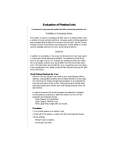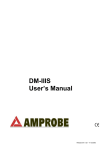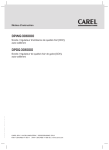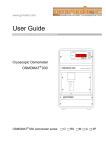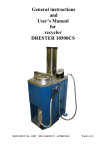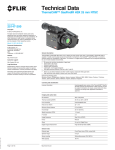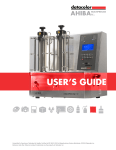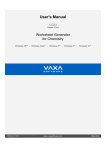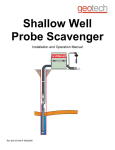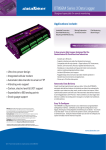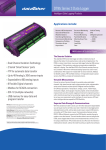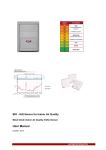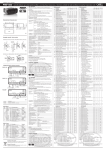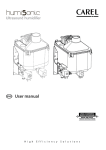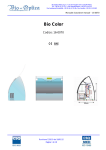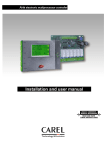Download DPWQ 306000 DPDQ 306000
Transcript
Operating instructions, mounting & installation DPWQ 306000 Room air quality sensor ⁄ - controller (VOC), self-calibrating DPDQ 306000 05 000 1291 13/06/2007 REV.1.0 (GB) 1001 IX ⁄ 07 Duct air quality sensor ⁄ - controller (VOC), self-calibrating CAREL SPA | VIA DELL‘INDUSTRIA | 35020 BRUGINE ⁄ ITALY FON + 39 0499 ⁄ 71 66 11 | FA X + 39 0 499 ⁄ 71 66 00 | w w w.carel.com ENGL ISH DPWQ 306000 Room air quality sensor ⁄ - controller (VOC), self-calibrating, with active output APPLICATION: The self-calibrating microprocessor-controlled duct air quality sensor is used to determine the air quality on basis of a mixed gas sensor ⁄ VOC sensor (VOC = volatile organic compounds). It is used: - To measure the air quality in offices, hotels, meeting rooms and convention centres, apartments, stores, and restaurants, etc. - For quantitative evaluation of room air pollution with contaminating gases (cigarette smoke, body perspiration, exhaled breathing air, solvent vapours, emissions from building members and cleaning agents) - For adjustable sensitivity regarding the maximum air contamination to be expected - For room ventilation on an as-needed basis, conserving energy by air changes only taking place when air is polluted. Room air quality is understood as subjective air quality, felt by human beings with their olfactory organs. As perception varies from person to person and therefore, air quality is assessed differently, a general definition of criteria for room air quality is not possible. Due to linearising and high operating temperatures, the air quality sensor achieves marginal drift and good stability. The sensor is automatically self-calibrating. The air quality sensor does not trace concentrations of individual gases, but assesses the mixed gas as such, i.e. gas concentrations are not measured selectively. Therefore, it is not possible to specify gas concentrations by the unit ppm. Detectable gases: mixed gas, vapours of alcanoles, cigarette smoke, automobile exhaust gases, exhaled breathing air, combustion smoke (from wood, paper, plastics). In addition, compounds of alkanes, alkenes, aromats, terpenes, halogenated hydrocarbons, esters, aldehydes and ketones as well as native VOCs such as terpenes and isoprene rank among volatile organic compounds VOC. VOCs also evaporate from chemicals products used in construction such as coating compounds, adhesives, or sealing compounds, furnishings, cleaning and care products, office chemicals and floor carpeting. The sensor‘s lifetime depends on the type of burden and gas concentration. TECHNICAL DATA: Power supply: .........................24 V AC ⁄ DC, current consumption ca. 70 mA at 24 V Sensor: ....................................VOC sensor (metal oxide) Measuring range: ..................0…100 % air quality; referred to calibrating gas Output signal: .........................0 - 10 V (0 V = clean air, 10 V = polluted air) or 4 … 20 mA (selectable via jumper) Measuring accuracy: .............± 20 % of final value (referred to calibrating gas) Ambient temperature: ..........0 ...+ 50 °C Detection of gases: ...............not selective Electrical connection: ............0.14 - 1.5 mm ² via terminals on circuit board Long-term stability: ...............< 10 % ⁄ per year Warm-up period: ...................1 hour Response time: ......................< 60s Enclosure: ...............................plastic, material ABS, colour pure white (similar RAL 9010), stainless steel enclosure optional Dimensions: ............................79 x 81 x 26 mm Installation: .............................on-wall or on in-wall flush box Ø 55mm, base with 4 holes for mounting on vertically or horizontally installed flush boxes, with predetermined breaking point for on-wall cable entry Protection class: ....................III (according to EN 60 730) Protection type: .....................IP 30 (according to IEC 529) Standards: ..............................CE conformity, electromagnetic compatibility according to EN 61 326 + A1 + A2, EMC directive 89 ⁄ 336 ⁄ EWG low-voltage directive 73 ⁄ 23 ⁄ EWG DPWQ 306000 ENGL ISH Dimensional drawing DPWQ 306000 Circuit diagram DPWQ 306000 GND terminals (1) and (3) are connected on the circuit board. Connecting diagram DPWQ 306000 Type ⁄ WG1 Range Air quality Output DPWQ 306000 0 …100 % 0 - 10 V ⁄ 4 … 20 mA Note: This air quality sensor must not be used as safety-relevant device! Features ENGL ISH DPDQ 306000 including mounting flange Duct air quality sensor ⁄ - controller (VOC), self-calibrating, with active output APPLICATION: The self-calibrating microprocessor-controlled duct air quality sensor is used to determine the air quality on basis of a mixed gas sensor ⁄ VOC sensor (VOC = volatile organic compounds). It is used: - To measure the air quality in offices, hotels, meeting rooms and convention centres, apartments, stores, and restaurants, etc. - For quantitative evaluation of room air pollution with contaminating gases (cigarette smoke, body perspiration, exhaled breathing air, solvent vapours, emissions from building members and cleaning agents) - For adjustable sensitivity regarding the maximum air contamination to be expected - For room ventilation on an as-needed basis, conserving energy by air changes only taking place when air is polluted. Room air quality is understood as subjective air quality, felt by human beings with their olfactory organs. As perception varies from person to person and therefore, air quality is assessed differently, a general definition of criteria for room air quality is not possible. Due to linearising and high operating temperatures, the air quality sensor achieves marginal drift and good stability. The sensor is automatically self-calibrating. The air quality sensor does not trace concentrations of individual gases, but assesses the mixed gas as such, i.e. gas concentrations are not measured selectively. Therefore, it is not possible to specify gas concentrations by the unit ppm. Detectable gases: mixed gas, vapours of alcanoles, cigarette smoke, automobile exhaust gases, exhaled breathing air, combustion smoke (from wood, paper, plastics). In addition, compounds of alkanes, alkenes, aromats, terpenes, halogenated hydrocarbons, esters, aldehydes and ketones as well as native VOCs such as terpenes and isoprene rank among volatile organic compounds VOC. VOCs also evaporate from chemicals products used in construction such as coating compounds, adhesives, or sealing compounds, furnishings, cleaning and care products, office chemicals and floor carpeting. The sensor‘s lifetime depends on the type of burden and gas concentration. TECHNICAL DATA: Power supply: .................................. 24 V AC ⁄ DC, current consumption ca. 70 mA at 24 V Sensor: ............................................. VOC sensor (metal oxide) Sensor protection: ......................... sinter filter, exchangeable, screwed, easy to clean Measuring range: ........................... 0 …100 % air quality; referred to calibrating gas Output signal: .................................. 0 - 10 V (0 V=clean air, 10 V=polluted air) or 4 … 20 mA (selectable via jumper) l Measuring accuracy: ...................... ± 20 % of final value (referred to calibrating gas) Ambient temperature: ................... 0 ...+ 50 °C Detection of gases: ........................ not selective Electrical connection: ..................... 0.14 - 1.5 mm ² via terminals on circuit board Long-term stability: ........................ < 10 % ⁄ per year Warm-up period: ............................ 1 hour Response time: ............................... < 60 s Enclosure: ........................................ plastic, material polyamide, 30 % glass-globe-reinforced, with quick-locking screws, colour pure white (similar RAL 9010) Dimensions: ..................................... 72 x 64 x 39.4 mm Process connection: ...................... by mounting flange, plastic, (included in the scope of delivery), galvanised steel optional Protection class: ............................ III (according to EN 60 730) Protection type: .............................. IP 65 (according to IEC 529) Standards: ....................................... CE conformity, electromagnetic compatibility according to EN 61 326 + A1 + A2, EMC directive 89 ⁄ 336 ⁄ EWG low-voltage directive 73 ⁄ 23 ⁄ EWG DPDQ 306000 ENGL ISH Dimensional drawing DPDQ 306000 Circuit diagram DPDQ 306000 Connecting diagram DPDQ 306000 GND terminals (1) and (3) are connected on the circuit board. Type ⁄ WG1 Range Air quality Output DPDQ 306000 0 …100 % 0 - 10 V ⁄ 4 … 20 mA Note: This air quality sensor must not be used as safety-relevant device! Features ENGL ISH Notes regarding DPWQ 306000 and DPDQ 306000 - This device may only be used in non-precipitating air without above-atmospheric or below-atmospheric pressure at the sensor element. - In the operating mode with current output, the device delivers an output current of either 0...20 mA or 4...20 mA (selectable via jumper). This device is not a transmitter. - The voltage output is short-circuit proof. - Applying overvoltage will destroy the device. - In case of pollution, we recommend cleaning and recalibration in the factory. - The air quality signal “good“...“bad“ is represented by the output signal 0...10 V. - The device operating range covers 10...95 % relative humidity respectively 0...50 °C. Beyond that range, mismeasurements or increased deviations will occur. - The chemical sensor is a consumable. The lifetime of the sensor depends on nature and concentration of the pollutant gas burden. - If this device is operated beyond the specified range, all warranty claims are forfeited. Air quality is measured through a chemical sensor. Due to its functional principle, the lifetime of the sensor depends on nature and concentration of the pollutant gas burden. The sensitive layer of the sensor element reacts with all volatile organic compounds and is thereby modified in its electrical properties or “exhausted“. This process results in a displacement of the characteristic curve. Such characteristic curve displacement however amounts to less than 15 % ⁄ year under normal burden. In measuring air quality, the general condition of air quality is detected. Whether air quality is “good“ or “bad“ is differently interpreted by each person. Different pollution burdens and concentrations influence the air quality signal (0...10 Volt) in different ways. Examples for this are cigarette smoke, deodorant sprays, cleaning agents, or also various adhesive materials for floor and wall coverings as well as dyestuffs. Increased burdens e.g. by solvents, nicotine, hydrocarbons, aerosol propellants etc. intensify consumption ⁄ aging of the sensor element. Particularly under high pollutant gas burdens – also during non-operational idle state periods of the devices (transport and storage) – zero-point drift will occur. Consequently, this must be corrected at site according to the respective circumstances or basic burdens. Air quality measuring instruments of different manufacturers cannot directly be compared because of different functional principles, preset basic burdens (zero-point), and permitted burdens (amplification ⁄ sensitivity). Devices are preset respectively calibrated according to the sensor manufacturer‘s specifications. Here, a zero-point and a final value is determined and thus a maximum burden. In particular cases, exceeding measuring ranges or excessive basic burdens on the devices will occur (outgassing floor carpeting, wall paint, etc.). In order to enable distinguishing different air qualities, devices need to be adjusted by the customer according to the conditions existing on site that do not correlate to the factory-preset definition range and calibration. Please note that factory calibration is thereby lost and compliance with technical data can no longer be guaranteed. Automatic calibration of air quality (default) The minimum initial value for air quality is memorized within a period of ca. 4 weeks. After that period has lapsed, the output signal is standardised to zero-point (1.0 V). The maximum amount of correction is thereby limited to 1 V ⁄ interval. In this way, long-term drifts and operational aging effects of the sensor element are completely eliminated. Manual calibration of air quality Manual calibration can be started independently from the position of jumper J3 by pushing the button. After connecting the device, a period of at least 2 hours of continuous operation of the device at „normal“ air quality is to be ensured. Manual calibration of the output signal to 1 V (zero-point) is started be pressing the button „Manual calibration“ (for ca. 5 seconds). Preparing for calibration is indicated by a blinking LED. Setting the output to 1 V at actual ambient conditions follows automatically thereafter. During this phase, the LED is permanently activated. After calibration is completed, the LED is deactivated. Putting in operation Upon energizing the device, a self-test and tempering takes place. Depending on ambient conditions, this process takes 3 to 5 minutes. During that time, the output analog voltage deviates from the actual measured value. ENGL ISH Our “General Terms and Conditions for Business“ together with the “General Conditions for the Supply of Products and Services of the Electrical and Electronics Industry“ including supplementary clause “Extended Retention of Title“ apply as the exclusive terms and conditions. In addition, the following points are to be observed: - These instructions must be read before installation and putting in operation and all notes provided therein are to be regarded! - Devices must only be connected to safety extra-low voltage and under dead-voltage condition. To avoid damages and errors at the device (e.g. by voltage induction) shielded cables are to be used, laying parallel with current-carrying lines is to be avoided, and EMC directives are to be observed. - This device shall only be used for its intended purpose. Respective safety regulations issued by the VDE, the states, their control authorities, the TÜV and the local energy supply company must be observed. The purchaser has to adhere to the building and safety regulations and has to prevent perils of any kind. - No warranties or liabilities will be assumed for defects and damages arising from improper use of this device. - Consequential damages caused by a fault in this device are excluded from warranty or liability. - These devices must be installed by authorised specialists only. - The technical data and connecting conditions of the mounting and operating instructions delivered together with the device are exclusively valid. Deviations from the catalogue representation are not explicitly mentioned and are possible in terms of technical progress and continuous improvement of our products. - In case of any modifications made by the user, all warranty claims are forfeited. - This device must not be installed close to heat sources (e.g. radiators) or be exposed to their heat flow. Direct sun irradiation or heat irradiation by similar sources (powerful lamps, halogen spotlights) must absolutely be avoided. - Operating this device close to other devices that do not comply with EMC directives may influence functionality. - This device must not be used for monitoring applications, which solely serve the purpose of protecting persons against hazards or injury, or as an EMERGENCY STOP switch for systems or machinery, or for any other similar safety-relevant purposes. - Dimensions of enclosures or enclosure accessories may show slight tolerances on the specifications provided in these instructions. - Modifications of these records are not permitted. - In case of a complaint, only complete devices returned in original packing will be accepted. SUPPLY VOLTAGE: Connection scheme Individual operation Connection scheme Parallel operation For operating voltage reverse polarity protection, a one-way rectifier or reverse polarity protection diode is integrated in this device variant. This internal one-way rectifier also allows operating 0 - 10 V devices on AC supply voltage. The output signal is to be tapped by a measuring instrument. Output voltage is measured here against zero potential (0 V) of the input voltage! When this device is operated on DC supply voltage, the operating voltage input UB+ is to be used for 15...36 V DC supply and UB– or GND for ground wire! When several devices are supplied by one 24 V AC voltage supply, it is to be ensured that all ”positive“ operating voltage input terminals (+) of the field devices are connected with each other and all ”negative“ operating voltage input terminals (–) (= reference potential) are connected together (in-phase connection of field devices). All outputs of field devices must be referenced to the same potential! In case of reversed polarity at one field device, a supply voltage short-circuit would be caused by that device. The consequential short-circuit current flowing through this field device may cause damage to it. Therefore, pay attention to correct wiring! Reprints, in par t or in total, are only permitted with the approval of Carel SpA. Disposal of the product The appliance (or the product) must be disposed of separately in accordance with the local waste disposal legislation in force. WARNING The CAREL product is a state-of-the-art device, whose operation is specified in the technical documentation supplied with the product or can be downloaded, even prior to purchase, from the website www.carel.com. The customer (manufacturer, developer or installer of the final equipment) accepts all liability and risk relating to the configuration of the product in order to reach the expected results in relation to the specific installation and/or equipment. The failure to complete such phase, which is required/indicated in the user manual, may cause the final product to malfunction; CAREL accepts no liability in such cases. The customer must use the product only in the manner described in the documentation relating to the product. 05 000 1291 13/06/2007 REV.1.0 (GB) 1001 IX ⁄ 07 The liability of CAREL in relation to its products is specified in the CAREL general contract conditions, available on the website www.carel.com and/or by specific agreements with customers.








